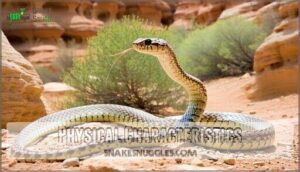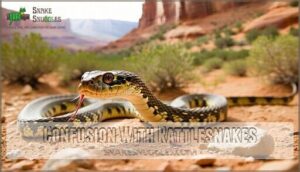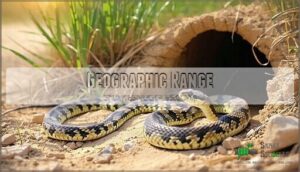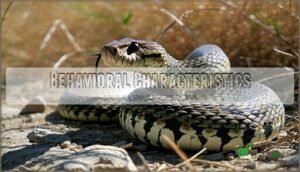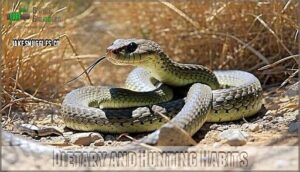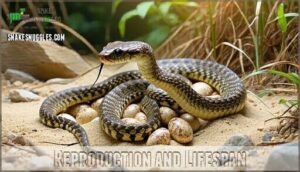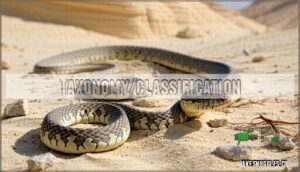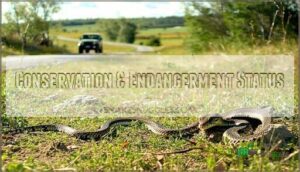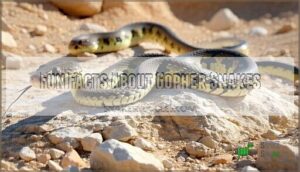This site is supported by our readers. We may earn a commission, at no cost to you, if you purchase through links.
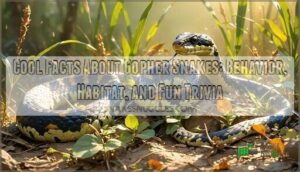
These non-venomous constrictors can grow over eight feet long and are surprisingly excellent climbers and swimmers.
They’re nature’s pest control experts, swallowing rodents whole after constricting them with powerful coils.
Gopher snakes live across North America, from deserts to grasslands, and can lay up to 24 eggs at once.
Their theatrical defensive displays fool both predators and humans, making them master performers in the snake world with fascinating survival strategies.
Table Of Contents
- Key Takeaways
- Physical Characteristics
- Confusion With Rattlesnakes
- Geographic Range
- Habitat
- Behavioral Characteristics
- Dietary and Hunting Habits
- Reproduction and Lifespan
- Taxonomy/classification
- Conservation & Endangerment Status
- Fun Facts About Gopher Snakes
- Frequently Asked Questions (FAQs)
- What are some fun facts about gopher snakes?
- How long can a gopher snake go without eating?
- Why is it called a gopher snake?
- How long does a gopher snake live?
- Can gopher snakes climb trees effectively?
- Do gopher snakes make good pets?
- How fast can gopher snakes move?
- What predators hunt adult gopher snakes?
- Do gopher snakes hibernate in winter?
- Conclusion
Key Takeaways
- You’ll be amazed by gopher snakes’ theatrical defense tactics – they flatten their heads, hiss loudly, and vibrate their tails against leaves to perfectly mimic deadly rattlesnakes, fooling both predators and humans with their Oscar-worthy performances.
- You’re looking at nature’s ultimate pest control experts that can grow over eight feet long and swallow rodents whole after constricting them with powerful coils, making them incredibly valuable for keeping rodent populations in check.
- You’ll find these adaptable reptiles thriving across diverse North American habitats from deserts to grasslands, where they’re surprisingly excellent climbers and swimmers despite spending most of their time underground in burrow systems.
- You can distinguish them from dangerous rattlesnakes by checking their round pupils (not slit-like), and you’ll be relieved to know they’re completely non-venomous constrictors that live 12-15 years in the wild but can reach over 30 years in captivity.
Physical Characteristics
Gopher snakes are impressive creatures, often stealing the show with their size.
With their dramatic hissing and tail-rattling theatrics, gopher snakes are nature’s ultimate drama queens putting on quite the show!
These snakes can grow from 36 to 96 inches long, making them one of the larger nonvenomous species.
Their gopher snake appearance is marked by a thick body, a narrow head slightly wider than their neck, and their distinctive scale type—keeled scales that give them a rough texture.
The gopher snake coloration varies by subspecies, but most have pale, cream-to-tan bodies with bold, dark body markings like blotches or saddles running down their backs.
Smaller spots along their sides add character, while their bellies are lighter, often cream with subtle dark patterns.
When stressed, they’re drama queens!
Gopher snakes hiss loudly, flatten their heads to up their intimidation game, and even rattle their tails like they’re starring in a rattlesnake impersonation contest.
Their scales, like other snakes, offer camouflage and protection.
Confusion With Rattlesnakes
Mistaking a gopher snake for a rattlesnake? It’s easier than you think! With their rattlesnake mimicry, these clever critters flatten their head into a triangular shape, shake their tail to create a buzzing noise, and hiss loudly when threatened.
These defensive behaviors serve as a self-defense mechanism, scaring off predators with rattlesnake-like similarities. As detailed in a recent study, gopher snakes are non-venomous, unlike rattlesnakes.
But here’s the key: gopher snakes have round pupils, not slit-like ones like dangerous rattlesnakes. So next time you spot one, check those pupil differences – it’s the ultimate clue in the "gopher snake vs rattlesnake" mystery!
Geographic Range
In terms of spreading out, few snakes rival the incredible range of Pituophis catenifer, or the gopher snake.
These adaptable reptiles call a sprawling territory home, stretching from southern British Columbia down through Northern Mexico. They’ve set up shop in deserts, forests, prairies, and marshes, showing off their knack for thriving just about anywhere.
In the U.S., you’ll spot them in western states like California, Arizona, and New Mexico. They don’t pack their bags for migration but hunker down in hibernate mode during winter.
With their ability to adapt, they’re key to their ecosystems—predators and prey in the food chain. As of now, their numbers are steady, earning them a comfortable “Least Concern” spot on the IUCN Red List.
They’re known to spend the majority of their time in underground burrow systems to avoid predators.
Habitat
Regarding gopher snake habitat, these adaptable reptiles thrive in a surprising variety of environments. From deserts and prairies to woodlands and agricultural fields, their ability to adjust is impressive.
Thanks to their burrowing behavior, they dig their own underground hideouts or take over abandoned burrows for shelter.
Here’s what makes their snake habitats interesting:
- Habitat Preferences: Open areas like grasslands and shrublands are ideal because prey is plentiful.
- Habitat Adaptations: They tolerate altitudes from sea level to over 9,000 feet, thriving in dry or semi-arid zones.
- Habitat Threats: Predators like hawks or coyotes target them, but their clever mimicry helps them avoid danger.
Gopher snakes, like other species, are affected by habitat destruction and change.
These snakes are nature’s tireless survivalists!
Behavioral Characteristics
Ever wonder how gopher snakes defend themselves? Their mimicry of rattlesnakes is a clever self-defense mechanism—they hiss, flatten their heads, and vibrate their tails to fool predators.
Nature’s greatest con artists: gopher snakes fool everyone with their Oscar-worthy rattlesnake impressions!
These solitary snakes stick to home territories, sometimes sharing brumation dens in winter. During warmer months, they’re active by day, shifting to dawn and dusk when it’s hot.
Gopher snake behavior includes impressive defensive behaviors and vocalizations, like loud hissing, which makes them seem fiercer than they are. As detailed in a snake characteristics guide, snakes utilize varied locomotion methods.
Surprisingly, they’re excellent climbers and swimmers too!
Dietary and Hunting Habits
If you’re curious about the gopher snake diet, it’s all about versatility.
These expert hunters rely on burrow hunting to ambush their favorite prey, including rodents, birds, and small reptiles.
Their hunting behavior involves constriction, a method that efficiently subdues snake prey.
Thanks to their varied diet, gopher snakes adapt well to seasonal changes, thriving in many environments.
By targeting rodents, they play a vital role in pest control. Their feeding habits are influenced by environmental temperature and humidity.
Quick, silent, and resourceful, their dietary impact keeps ecosystems in balance.
Reproduction and Lifespan
Gopher snakes have fascinating breeding habits, being oviparous, or egg-laying reptiles.
During the breeding season between June and August, females lay 2-24 eggs, which undergo egg incubation for 65-75 days.
Hatchling survival is remarkable, as the young are independent at birth.
Males mature at 1-2 years, while females take 3-5 years.
In the wild, gopher snake lifespan is 12-15 years, but they can reach a captive lifespan of over 30 years!
Similar to ball pythons, gopher snakes can benefit from controlled habitat conditions to maximize their lifespan.
These snakes don’t need to babysit—hatchlings thrive on their own!
Taxonomy/classification
When exploring snake taxonomy, you’ll find gopher snakes (Pituophis catenifer) proudly representing the diverse Colubridae family.
These reptiles are masters of survival, boasting six fascinating subspecies like the Sonoran and bullsnake. Their genetic diversity and adaptations highlight an incredible evolutionary history.
Did you know they can exhibit hybridization potential, especially in overlapping ranges? Taxonomists occasionally debate their classification, sparking discussions on taxonomic revision.
But regardless of labels, these non-venomous charmers remain essential to ecosystems. Identifying gopher snakes is simple: focus on patterns, behaviors, and size—it’s all part of their expertly developed disguise.
Their scales contribute substantially to camouflage or warning.
Conservation & Endangerment Status
Gopher snake conservation is a vital part of wildlife preservation. Thankfully, they don’t have a threatened status, but their populations face some challenges.
Habitat loss from urban sprawl, road mortality from busy highways, and invasive species disrupting ecosystems all put pressure on these snakes.
Here are three key facts about their conservation status:
- Habitat Loss: Expanding cities reduce the grassy areas and burrows gopher snakes need.
- Road Mortality: Many snakes fall victim to vehicles while crossing roads.
- Climate Change: Rising temperatures can impact their prey availability and habitats.
Conservation efforts, like preserving natural habitats and raising awareness about snake preservation, help keep these incredible reptiles thriving. Like other snakes, such as ball pythons which depend on specific humidity levels, gopher snakes require particular environmental conditions.
Gopher snakes play a big role in rodent control, so their survival benefits everyone!
Fun Facts About Gopher Snakes
Despite their intimidating reputation, you’ll find gopher snakes are full of surprises that’ll change how you see these remarkable reptiles.
- Unique Vocalizations – They’re among the few snakes that can "bark" and produce deep hisses using vocal cords, making them nature’s snake ventriloquists.
- Master Mimics – These gopher snake adaptations include flattening their heads and vibrating tails to fool predators into thinking they’re dangerous rattlesnakes.
- Brumation Habits – They hibernate in groups with other snake species, creating underground snake communities during winter months.
- Urban Dwellers – You might spot them in city parks and suburban areas where they help control rodent populations naturally.
- Sun Basking Experts – They spend 90% of their lives underground but risk skin cancer when basking in sunlight for warmth.
- Constriction Methods – They squeeze prey with powerful muscles rather than using venom, wrapping around victims like living ropes.
- Egg-cellent Parents – Females lay up to 24 eggs in shared nesting sites, then abandon them completely—talk about tough love parenting.
- Geographic Giants – These snake facts include their massive range covering 24 U.S. states from Canada to Mexico.
- Longevity Champions – Wild gopher snakes live 12-15 years, but captive ones can reach over 30 years with proper care.
- Snake Misconceptions Busted – Despite gopher snake behavior that mimics venomous species, they’re completely harmless to humans and beneficial ecosystem partners.
They’re known to thrive in diverse North American ecosystems, from deserts to grasslands.
Frequently Asked Questions (FAQs)
What are some fun facts about gopher snakes?
Looks can be deceiving! You’ll find gopher snakes masterfully impersonate rattlesnakes by flattening their heads, hissing loudly, and vibrating their tails.
They’re excellent pest controllers, devouring rodents while staying completely harmless to you.
How long can a gopher snake go without eating?
When food’s scarce, you’ll notice these snakes can survive several months without eating.
Their metabolism slows dramatically during winter brumation, allowing them to fast for up to six months while conserving energy underground.
Why is it called a gopher snake?
You’ll find they’re called gopher snakes because gophers make up their primary diet. These skilled hunters spend most of their time underground, following gopher tunnels to catch their favorite prey.
How long does a gopher snake live?
You’ll find gopher snakes living quite different lifespans depending on their circumstances. In the wild, they typically live 12-15 years, but captive ones can exceed 30 years with proper care.
Can gopher snakes climb trees effectively?
You’d think these ground-dwelling serpents would be hopeless climbers, but gopher snakes actually scale trees quite well.
Their muscular bodies and keeled scales provide excellent grip, letting them pursue birds and eggs in branches.
Do gopher snakes make good pets?
Gopher snakes can make decent pets if you’re experienced with reptiles.
They’re docile, live 20+ years, and don’t need daily interaction.
However, they require specific heating, large enclosures, and aren’t cuddly companions.
How fast can gopher snakes move?
You won’t see these snakes breaking any speed records.
While exact speeds aren’t well-documented, gopher snakes move at a moderate pace, likely around 2-4 mph when actively hunting or escaping danger.
What predators hunt adult gopher snakes?
Hawks, owls, foxes, coyotes, and larger snakes like king snakes will hunt you if you’re an adult gopher snake.
Even skunks and raccoons might grab you, though they typically prefer smaller prey.
Do gopher snakes hibernate in winter?
Like bears retreating to their dens, you’ll find gopher snakes don’t truly hibernate but brumate—entering a dormant state underground during winter.
They’ll often huddle together with other snake species in shared burrows for warmth.
Conclusion
Understanding these cool facts about gopher snakes reveals why they’re among nature’s most fascinating reptiles.
You’ve discovered how they masterfully mimic rattlesnakes, adapt to diverse habitats, and serve as essential pest controllers.
Their impressive climbing abilities, swimming skills, and theatrical defense mechanisms showcase remarkable evolutionary adaptations.
Whether you encounter one in your backyard or spot one during a nature hike, you’ll now appreciate these non-venomous constrictors as the incredible survival artists they truly are.

